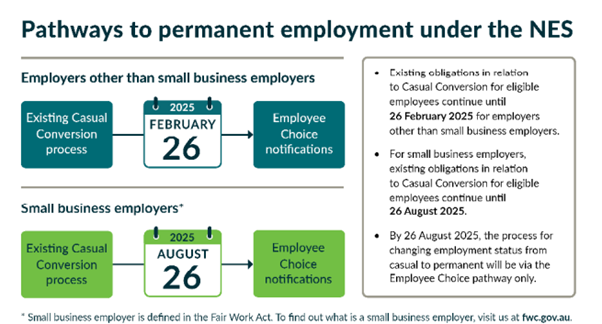Changes to casual employment legislation
On 26 August, under the recent Closing Loopholes legislation, significant changes to casual employment legislation in Australia took effect. These key changes aim to redefine casual employment and streamline the process for casual employees to transition to permanent employment. Let’s look at both of these key changes.

New definition of casual employment
An employee will be considered casual only if:
- there is no firm advance commitment to continuing and indefinite work, and
- they are entitled to a casual loading or a specific rate of pay for casuals under an award or employment contract.
When considering if an employee has a firm advance commitment to continuing and indefinite work, specific matters need to be considered such as whether:
- the employer can choose to offer or not to offer work and whether the employee can choose to accept or reject work
- it is likely that there will be future continuing work available
- permanent employees perform the same kind of work that the employee usually performs, and
- the employee performs a regular pattern of work.
A new pathway to permanent employment - Employee Choice Pathway
As of 26 August, a new pathway has been introduced for eligible employees to transition to permanent employment if they wish to do so, enabling the employee to request in writing a change to permanent employment if they:
- have worked for the employer at least 6 months (12 months for a small business employer who employees fewer than 15 employees) and
- believe they no longer meet the definition of casual employee.
If the employee is employed at a practice with at least 15 employees and wishes to use the Employee Choice Pathway, the earliest they can request a transition to permanent employment would be 26 February 2025 as displayed in the diagram below.

The employer must:
- respond in writing within 21 days to the employee’s request
- confirm in the response the employee’s work hours and effective date of change
The employer may refuse the notification on the following grounds:
- the employee still meets the definition of a casual employee
- there are fair and reasonable operational grounds for not accepting the notification, such as:
- substantial changes would be required to the way work in the employer’s business is organised
- there would be significant impacts on the operation of the employer’s business, or
- substantial changes to the employee’s employment conditions would be necessary to ensure the employer doesn’t break rules (such as in an award or agreement) that apply to the employee
- accepting the change would mean the employer won’t comply with a recruitment or selection process required by law
- are engaged in an ongoing dispute with between the employee and employer about changing to permanent employment under the employee choice pathway, or
- in the previous six months, the request for casual conversion was refused or resolved a dispute about employee choice under a relevant dispute resolution process.
Employer obligations and protections
Employers must provide an employee with the Casual Employment Information Statement along with the Fair Work Information Statement on commencement of employment and the Casual Employment Information Statement upon the completion of six months' employment, 12 months' employment and then every 12 months thereafter.
Casual Employment Information Statement (fairwork.gov.au)
Recommended actions
- Continual discussions with casual candidates at the interview and post employment the reasons justifying the legitimate lack of ongoing commitment and records kept of these discussions.
- Reviewing the casual employees working patters monthly against the amended definition of casual employment as outlined above.
- Where practicable casual employees should be offered permanent employment if the assessment finds circumstances have changed since the commencement of employment. This will help mitigate the risk of being found to have misrepresented a casual employment relationship by the Fair Work Commission.
- Setting reminders to trigger a casual employee’s length of employment in order to meet the obligation of sending a copy of the Casual Employment Information Statement on employment, then six months, 12 months and every 12 months thereafter.
The Workplace Relations Team sent an email to Toolkit subscribers on Friday 23 August relating to legislative changes impacting casual employment, please call 07 3872 2264 or email us at workplacerelations@amaq.com.au if you are a paid subscriber to any of our services and would like a copy of the email.